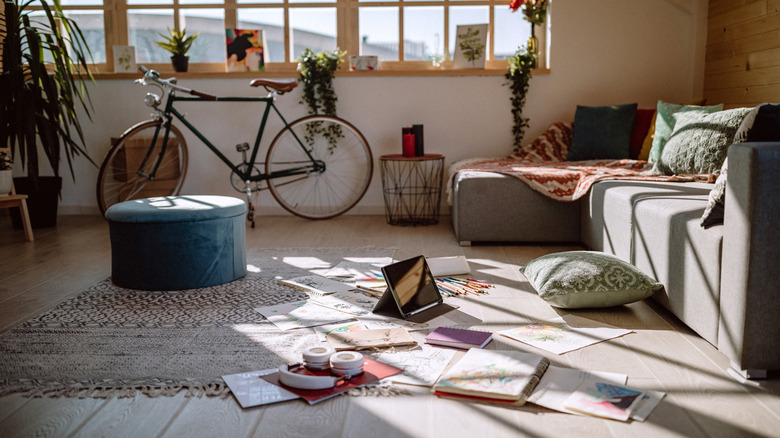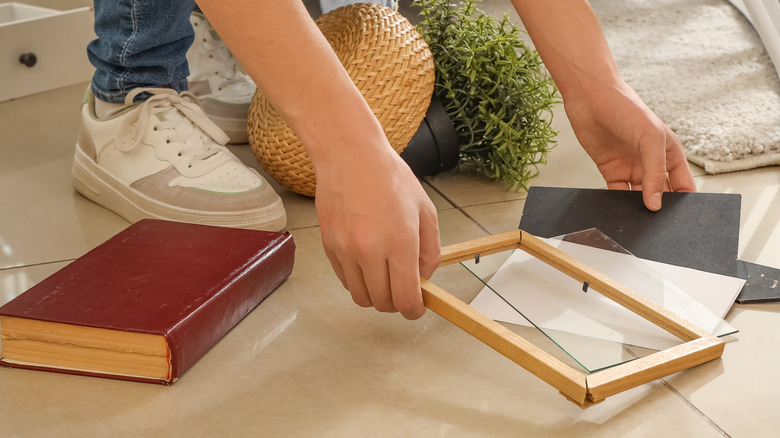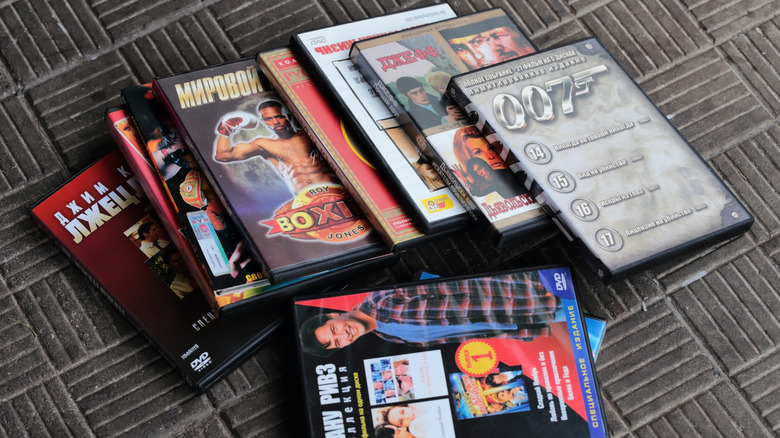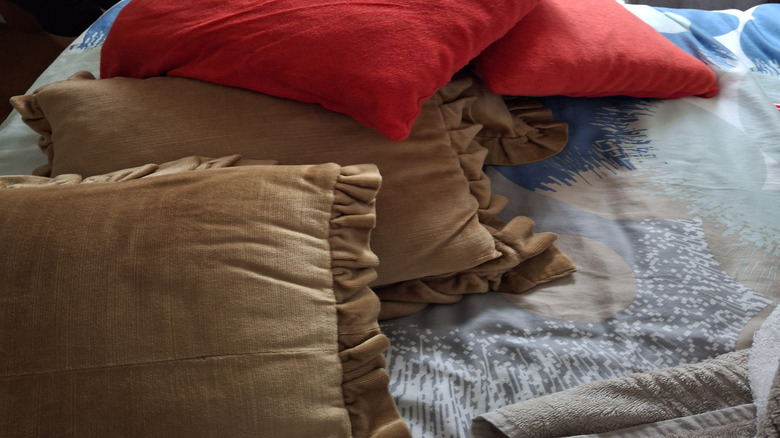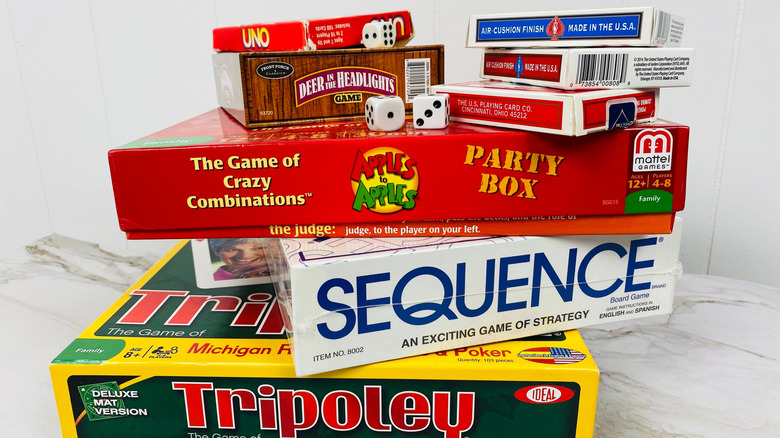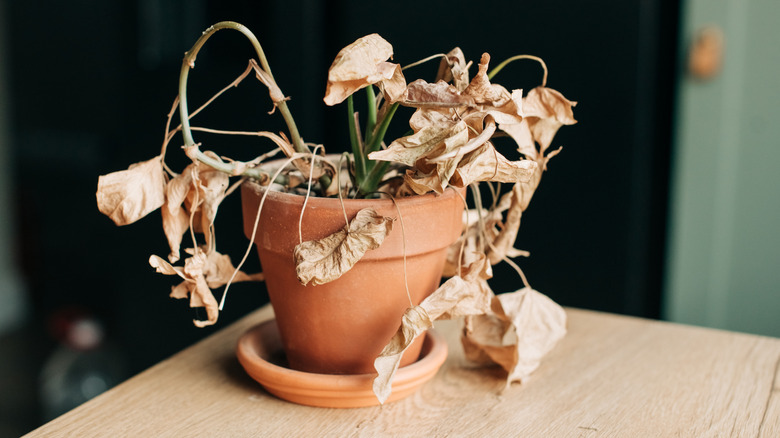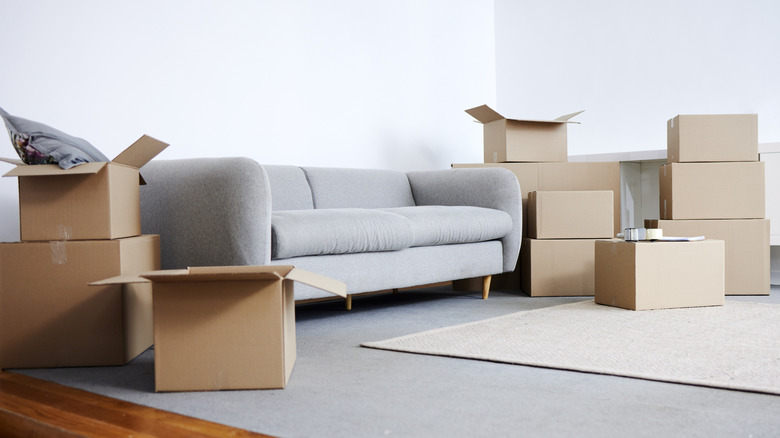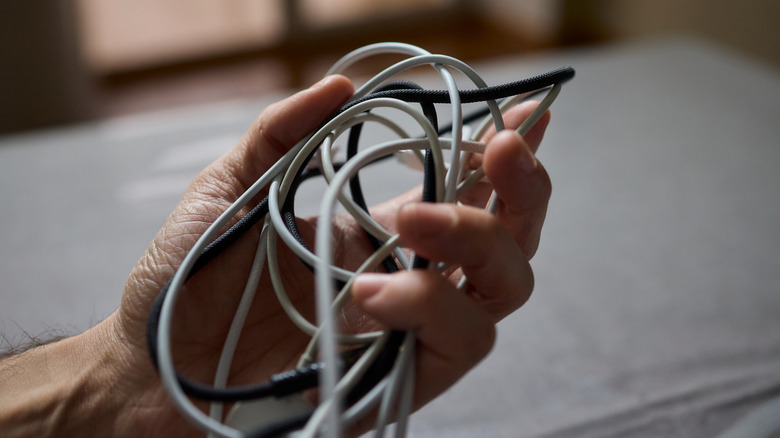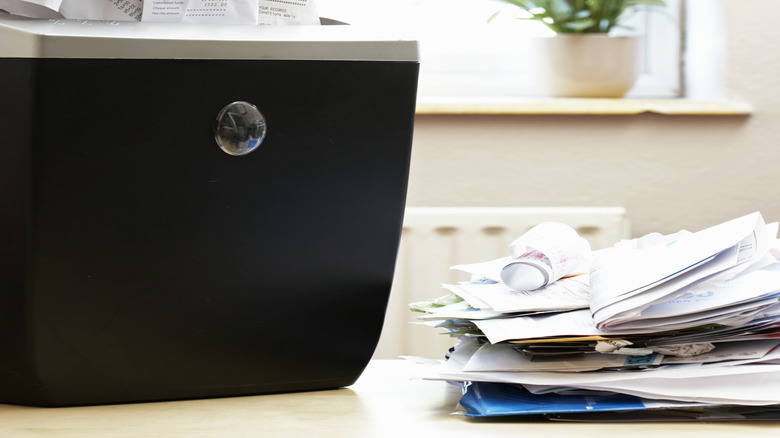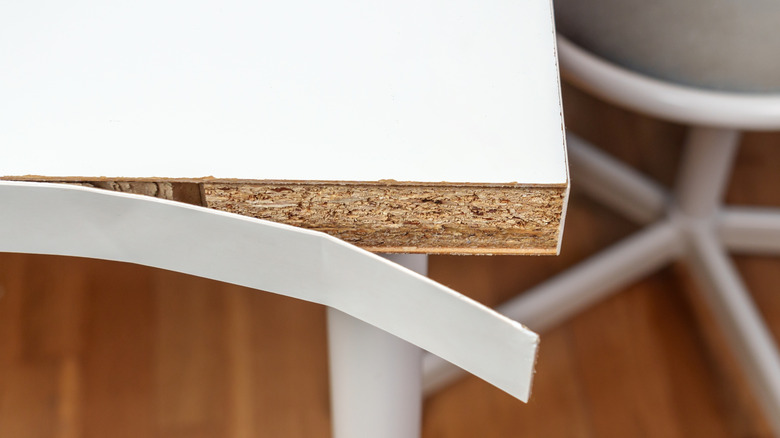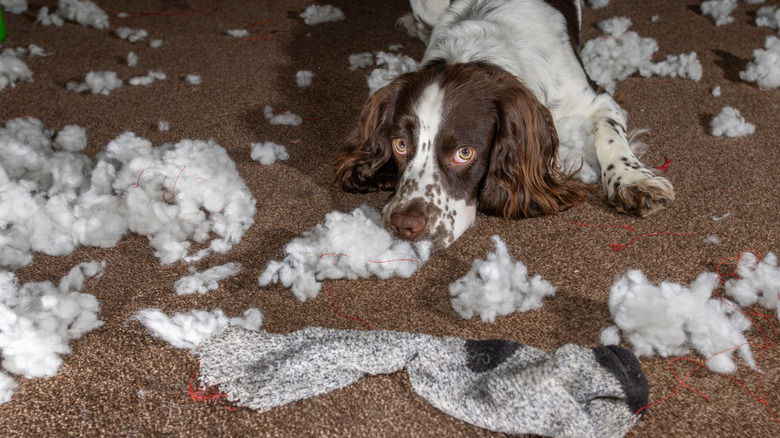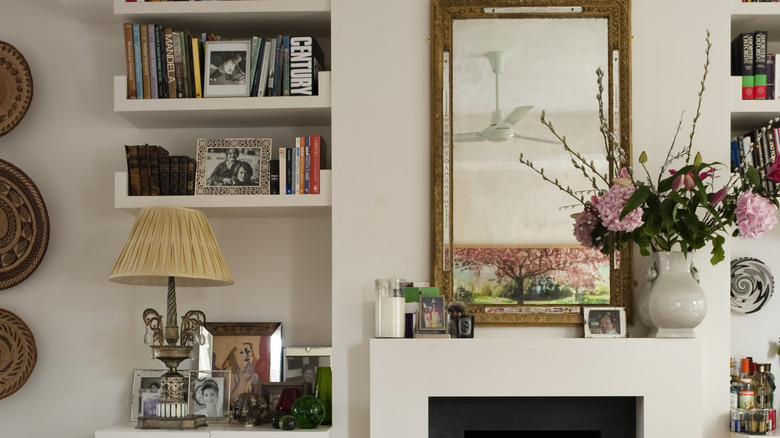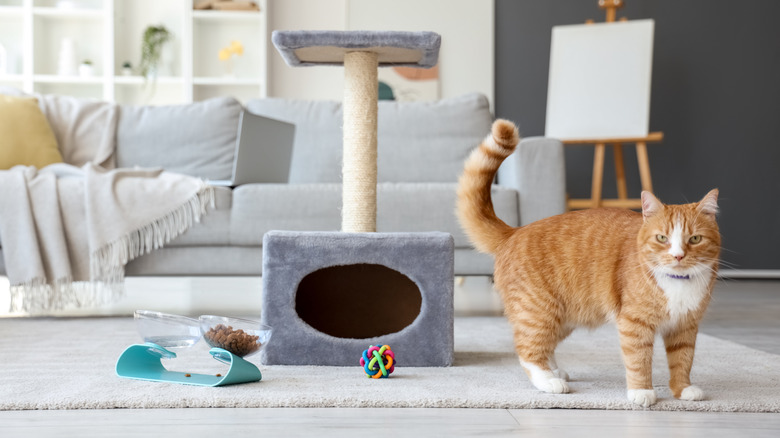14 Items You Can Toss To Declutter Your Living Room On The Spot
A living room is supposed to offer a comfortable space to relax, entertain guests, and spend time with the family. If your living room is cluttered, however, it can make all of these activities difficult. A messy space can also add undue stress to your daily life, impacting more than just your ability to relax when you're sitting in the living room.
Many of us are hesitant to get knee-deep into a decluttering project. We often assume that the task will take hours of our time and still won't have the impact we desire. So, the first step to decluttering your living room is to change your way of thinking. There are several items that you can quickly toss right now — either in the trash, the recycling bin, or a charitable collection box. And, this decluttering can immediately give you a cleaner slate. Here are a few small changes that can quickly make a huge difference in the aesthetics and functionality of your living room.
Let go of broken picture frames and knick knacks
If you've been using tape to keep a picture frame from falling apart or a bit of glue to secure a broken piece of a knick-knack, maybe it's time to let the items go. Even if they were once attractive, broken decor items don't add anything positive to your space. In fact, they have the opposite effect, making it look messy and not very aesthetically pleasing. Ask yourself whether you really need a broken decor item, such as a picture frame, a vase, or a cracked figurine. Unless it's a priceless piece or has sentimental value, the answer is likely no.
Once you've accepted that letting these broken items go is the best course of action, your next step is to get them out of your living space. The material(s) from which they're made will determine the best way to get rid of them. For example, a metal picture frame and its glass panel are likely recyclable, while a ceramic knick-knack will need to be thrown out. Be sure to check with your local municipality to confirm which materials are recyclable and whether any of these materials need to be separated or brought to a special facility.
You're never going to use that old DVD (or VHS) collection
Do you still have a collection of DVDs (or even worse, VHS tapes) under the television in the living room? Chances are, you don't still have a VCR or DVD player, so these old media items are likely just collecting dust, taking up space, and adding to the cutter. With few exceptions (perhaps old family movies, a wedding tape, the recording of a child's choir performance) there's no reason to keep these items anymore.
DVDs, and sometimes VHS tapes, are recyclable. However, you'll likely need to bring them to your local recycling center instead of just putting them in your curbside bin. VHS tapes are considered e-waste, so it is especially important to make sure you dispose of them properly. If you are not sure whether your local recycling center accepts these, try searching for "e-waste recycling near me," and a list of some approved collection locations should come up.
Even those VHS or DVDs with sentimental memories on them don't need to stay in your living room. In fact, to preserve these memories as technology continues advancing, it's best to get them digitized, especially since VHS tapes degrade over time. There are several businesses that offer these services. You should be able to find someone local, if not online, who can help you transfer the content to a more modern storage format or onto a secure cloud.
Recycle piles of newspapers and magazines that you won't read
If you're an avid follower of fashion, interior design, or current events, then you may have several magazine and newspaper subscriptions. Even if you only get one or two publications delivered each month, it doesn't take long for piles to start covering your living room tables. Beyond adding to the clutter, all of these are dust magnets. So, they could be actually making your space dirtier and more challenging to clean.
Because of this, let them go. If you're saving something because there's an article you've been waiting to read, tear it out or take a picture of that page so you can read it digitally at a later time. Newspapers and magazines are recyclable, but you may also be able to donate them to someone who could put them to good use. For example, depending on the types of magazines, a local art teacher may be interested in using them to make collages with their students. Or if one of your neighbors has pets, they may be interested in repurposing the newspapers in their cat's litter box or by lining their bird's cage.
Toss flat or worn throw pillows
Throw pillows for a couch have a few functions. First, they serve as a decor item, complementing your room's color scheme and overall design. They also serve a practical function. Family members or guests who want extra neck or back support while lounging can use the pillows to make themselves comfortable. However, if your throw pillows are flat, tattered, or in otherwise poor shape, they won't achieve either of these goals. They're simply adding to the cluttered look and feel of your room and taking up space that would be much better suited to some clean, new pillows.
Don't let yourself hold on to these uncomfortable eyesores. Unfortunately, you can't easily recycle throw pillows. Many community recycling programs don't allow people to place textiles in curbside collection bins. However, you may be able to find a textile collection bin in your area. Or, if the pillow is only flat and not torn or tattered, you may also be able to donate it to a local animal shelter.
Say goodbye to board games or puzzles that are missing pieces
Are the shelves in your living room overflowing with puzzles and board games? If so, it may be time to assess your collection. Even if they're neatly stacked, so many boxes will detract from the look and feel of your space, making it feel cramped. We're not advising that you get rid of your entire game collection. However, there is no reason to save any that are missing pieces. A missing piece means you'll never be able to fully complete the puzzle (which, we all know isn't very satisfying), and you likely need all of the pieces to play your board games.
Don't allow these clunky boxes to take up precious space any longer. Sort through your collection and pull out any that you know are incomplete. You could even make this a family event by playing each game or putting together each puzzle one at a time to see which ones are missing parts. Once you've set aside any that aren't complete, you can recycle or throw out the pieces. Many of the components should be recyclable, but you'll need to verify with your community recycling center.
Don't keep dead plants or flowers that can't be resuscitated
Even if you have a green thumb, you may lose a few plants every now and then. If any of your plants have died, they no longer belong in your living room. Beyond looking sad and gloomy, they may be attracting pests, and they're definitely adding unnecessary clutter. Similarly, if you received flowers for your birthday, anniversary, or another holiday recently, don't let them hang around so long that they start drying out and dropping leaves and petals.
Dead plants and flowers should be tossed. Or, better yet, if you compost at home or if your community offers a compost drop-off, put these old plants to better use by composting them. Save the vase or pot (only if you're certain you'll use it again) before tossing them. If you're reluctant to recycle them because you're not sure whether your plants are actually dead, there are a few things you can check to verify. First, take a look at the stems. If they are brown or brittle, chances are the plant isn't still alive. You can also verify by carefully digging down to the root. If these are also brittle (or overly soft and spongy) you can feel confident that the plant is dead and that there is no benefit to saving it.
Toss any boxes and packing materials from recent deliveries
If you're like many, you do a lot of your shopping online. While this is convenient, all of those boxes and packing materials can build up quickly. If you've got a pile of them in the living room, you've just identified a quick and easy way to instantly declutter. Boxes are clunky and, while important during transit, all of that brown paper packaging or bubble wrap can make your space look cluttered and messy.
Take a few minutes of your time to break the shipping boxes down. You could even save one or two to help you collect and dispose of the other items you're getting rid of. Many local recycling programs will accept these boxes along with paper packaging materials. But, again, it is good to check with your local center if you're not certain which materials they accept (or will pick up curbside). For example, many community recycling programs won't take bubble wrap. However, if your local grocery store offers collection bins for plastic bags, they may also accept the packing material.
Cords you no longer know what they belong to aren't worth holding on to
We're all guilty of it. We have a drawer or shelf (or several drawers or shelves) that are full of all those extra cords and charging cables. While you'll want to organize all of these items (perhaps by trying the cord-corralling hack of using a shoe organizer) there are likely some that you should just get rid of entirely. Take time to go through all of those unwanted cords and pull out any that you haven't used in ages (and don't even know what they go to), as well as ones you know you don't need, such as the outdated one for the cell phone you got rid of five years ago.
Once you've pulled out the ones that need to go, you shouldn't just toss them in the trash can. Like other electronics, cords and cables are considered e-waste. As such, they must be recycled through an approved e-waste drop-off point. Some stores also provide e-waste recycling services. For example, Best Buy accepts up to three items per household each day, including cords and connectors.
Shred or recycle paperwork or bills
Don't let old bills, junk mail, receipts from the grocery store, and any other paperwork consume space in your living room. Piles of paperwork are the epitome of clutter. So, removing these can have a transformative effect on the space, even if it's the only change you make.
Take all of those piles of paperwork and bring them to the kitchen table or another large, flat surface. Do a quick sort into groups, such as shred, recycle, and keep. Dispose of the shred and recycle piles appropriately, then take a second look at that keep pile. There are ways to keep that paper clutter organized and prevent it from transferring the mess to your home office. Consider digitizing what you can and then label and neatly file the rest away.
Don't hang onto broken furniture
Do you have an old chair in your living room that you always tell guests to avoid sitting in? Maybe the seat has broken springs, or perhaps one of the wooden legs is hanging on by a thread. Either way, broken furniture doesn't need to continue taking up useful space and making your living room feel more cluttered. It's time to let it go.
How and where the furniture is broken will determine the best way to get rid of it. For example, there are ways to get rid of an old couch without dumping it. If it's only in need of a minor fix, you could consider donating the piece with a note about what needs to be fixed. Perhaps a handy friend or neighbor is looking for a new restoration project. If you feel shy asking around, you can also post it on your local Facebook Buy Nothing Group. However, if the furniture is broken beyond repair and simply isn't worth anyone's time or effort, then it may be destined for the dump. If you have a large enough vehicle and help to move it, you could bring it on your own. Otherwise, you might want to consider hiring a junk removal service to remove it from your property.
Chewed-up pet toys belong in the trash
If you have furry family members, your living room may also be their space to rest and play. While there is nothing wrong with keeping some beds or toys handy for them, you need to draw the line at any items that are chewed up, toys that are leaking filling, or bones with jagged edges. And yes, ragged toys are not only unattractive, they're also unsafe for your pets.
Dogs especially, but also cats, can get injured by swallowing stuffing or other small pieces of a toy. If these items are left in the living room, they are likely going to continue playing with them, increasing the chances that they'll accidentally ingest something that they shouldn't. This could have potentially serious consequences for your pet, as it could result in an intestinal blockage. So, periodically weed through your pet's toys and get rid of anything that is broken or falling apart. Your living room will look less cluttered, and you'll feel good about doing your part to keep your beloved pet safe and healthy.
Unfinished DIY projects should be tossed or moved to a better location
Many times we have grand plans about projects we want to complete around the house. Unfortunately, those grand plans don't always come to be. It is too easy to start a project and leave it unfinished. Perhaps you started a scrapbook, decided to try to create a piece of mosaic artwork, or thought you'd try your hand at decoupaging your coffee table. But then life happened, and you never got a chance to finish it. Now is the time to take any of these unfinished projects out of your living room.
Where they go from there will be up to you. Take an assessment of your endeavors and think about the reason they were never completed. If you didn't pick them back up because you got bored or lost interest in the task, chances are you probably won't want to finish them in the future. If you sincerely want to complete any of these projects, make a plan and stick with it. Then, find a new home for them out of the living room (perhaps in the laundry room or your home office).
Decor you no longer love doesn't deserve to take up space
Our preferences change over time. We find new pieces of art and decoration that we prefer over those that we picked out several years ago. However, many of us still keep those old pieces around, even though they no longer tug on our heartstrings like they used to. Why? Hanging onto something simply out of habit isn't a good reason to keep it at all. It's no longer bringing you joy and is simply one more thing to collect dust. And as you add more items to your shelves and surfaces, those old pieces can make the space feel cluttered and overstuffed.
If you have any photographs or paintings on the wall, knick-knacks on a shelf, or other decor items that fit in this category, don't allow them to continue adding to the cutter. Consider the value of the specific items you're ready to part with. This can help you decide whether they're worth trying to sell, or if you're better off giving them away through a Buy Nothing Group or a local charity.
Pieces you thought would be useful — but that you don't use very often — should go
Sure, that cat tree sounded like it would be an instant favorite for your feline friend. But, in true cat fashion, they never so much as look in its direction. Or maybe you thought that sofa tray would revolutionize movie night, but it just feels like extra work to pull it out, so it sits in the corner. Sound familiar? We've all made purchases that we thought would be life-changing, only to realize that the item isn't all that great. If you have any of these items that you never use, why are you still keeping them? One of the best ways to make your room feel less cluttered is to get rid of these things.
Since most of these items are likely unused or only slightly used, they likely don't belong in a landfill. Instead, consider trying to sell them online or through a local consignment shop. You could also consider donating them to a local charity or offering them up to your neighborhood Buy Nothing Group.
